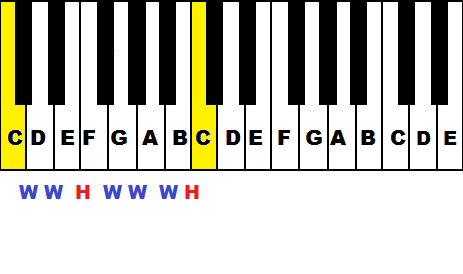Major Scales
If you've heard the Do-Re-Mi scale, then you already know what a major scale is, even if you haven't referred to it by that name before. For simplicity's sake, let's look at the notes of a C major scale:
C (Do)
D (Re)
E (Mi)
F (Fa)
G (So)
A (La)
B (Ti)
C (Do)
If you want to open up the Virtual Keyboard again and play those notes, you'll notice that the C scale consists of all white keys. Also remember the difference between whole steps and half-steps:

- The distance between two notes is a half step if there are no keys in between them (i.e., they're one semitone apart)
- The distance between two notes is a whole step if there is one key (either white or black) between them (i.e., they're two semitones apart)
Therefore, the major scale consists of the following intervals:
Whole Step - Whole Step - Half Step - Whole Step - Whole Step - Whole Step - Half Step
But don't take my word for it. Take this picture's:

See that? The picture doesn't lie.
So what if you wanted to play the same type of scale, but starting on D? Well, grab your piano, keyboard, or Virtual Keyboard and play the following notes:
D E F# G A B C# D
Even though the notes are different from those of the C major scale, you can probably tell that the two scales sound very similar. That's because the intervals are the same from the first to last note. Because of this, you can change the root of any scale or chord, yet retain the same quality (i.e. minor stays minor, major stays major, etc) by moving all of the notes the same amount in the same direction!
Take, for example, the two major scales I just showed you. To transform a C major scale into a D major scale, simply look at the distance between the notes C and D. D is one whole step above C. Therefore, move every note of the C major scale up a whole step. Voila!
Minor Scales
Now that I've already gone over the major scale and changing keys, the rest shouldn't take long.
The formula for a minor scale is the following:
Whole Step - Half Step - Whole Step - Whole Step - Half Step - Whole Step - Whole Step
Now, which minor scale should I show you? To keep things simple, let's once again go with the one with all white keys. Is that C? Nope! It's A:

That's right! C major and A minor have the same notes! Which means that the two are related:
A is the relative minor of C
Likewise, C is the relative major of A
Play both scales and listen to how different they sound.
This handy nugget of information can save us a lot of time. If you want to learn all 12 major and minor scales, you can shorten the process by just remembering all of the major scales (still a lot of work, I know). Once you do that, you can figure out, for example, the G minor scale by doing the following:
- Count up 3 semitones from G. That gives us Bb
- Figure out what notes are in the Bb major scale (I'll help you out. It's Bb - C - D - Eb - F - G - A - Bb
- Play that very scale, but starting on G. Therefore, you'll be playing G - A - Bb - C - D - Eb - F - G
If you've never learned scales before, this is probably a lot to take in at once. Fortunately, there aren't really any tricks. All it takes is a lot of practice and repetition to let this stuff sink in.
Next lesson, I'll be getting to the good stuff. I keep mentioning the infamous 6-4-1-5 progression without explaining in too much detail what that means. For now, I'll just say that the numbers themselves refer partially to the scale degree of the major scale (i.e. the 6th note in a major scale, then the 4th note, then the 1st, then the 5th). See if you can figure out the rest before the next entry!

No comments:
Post a Comment